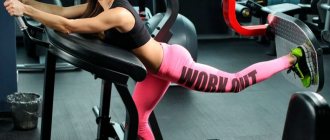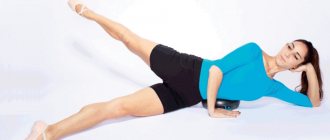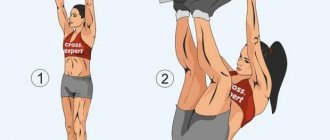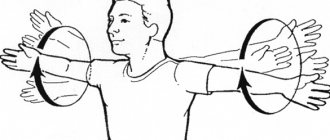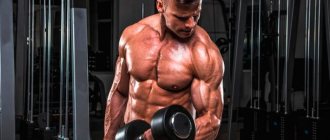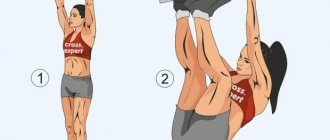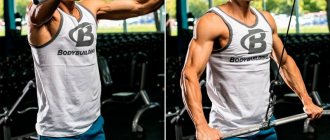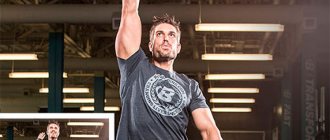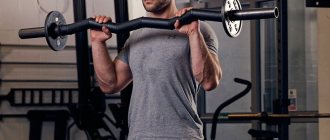The deltoid muscles consist of anterior, middle and posterior bundles. They participate in all pressing movements. Raising your arms forward, pressing away and up - this is their main function. The anterior deltoid works when we open a door, move our arm in front of us, or try to shake a barbell in the gym. This muscle is not large, but its development is important not only for aesthetics, but also for preventing injuries. Front raises are a great isolation exercise for the anterior deltoid.
Benefits and disadvantages of exercise
Pros:
- Swinging dumbbells in front of you is aimed at developing the anterior delta.
- The exercise can be performed with one hand, which allows you to correct asymmetry of the deltoid muscles or facilitate technique.
- This is a great option for home training.
- The exercise is suitable for both women and men.
- Dumbbell swings strengthen not only the shoulder muscles, but also the ligaments.
- Helps improve the quality (relief) of deltoids.
Minuses:
- The disadvantages of the exercise include possible pain and discomfort when performing, as well as working with light weights.
- In principle, dumbbell swings are performed as an additional load on the target muscles, so heavy weight is not as important here as proper technique and concentration.
Anatomy exercises
Raising dumbbells in front of you is an effective exercise for pumping and fully working out all the deltoid muscle bundles. When performing the exercise, you need to raise your arms forward; accordingly, the main load will fall on the anterior bundle of deltoid muscles. In addition, the middle delta is also involved in the exercise: it helps stabilize the position of the arm when lifting weights. Exercise also has an effect on:
- pectoral muscles (mainly the upper part);
- biceps;
- trapezius muscles;
- abdominal muscles;
- serratus muscle.
Lifting dumbbells requires stabilization of the core, so the abdominal, back and leg muscles are also involved a little.
When lifting dumbbells, different muscle groups work
The exercise is quite universal. Absolutely all categories of people can perform it (men and women, beginners and professional athletes, children and older people). This exercise is only not recommended for those who have recent injuries (less than one year) to the shoulder or abdomen. Lifting dumbbells, especially with heavy weights, is a rather traumatic exercise. Therefore, it is not recommended to perform it if you are feeling unwell. If you feel weak and dizzy while performing the exercise, it is better to stop the exercise to prevent injury.
What muscles work
This is an isolating exercise for training the anterior deltoid; however, the load on the middle part cannot be completely eliminated.
Other muscles are also involved during the exercise. They work as stabilizers . These include: leg muscles, abdominal and lower back muscles, lower trapezius, rhomboids and other deep spinal stabilizer muscles.
Posterior deltoid muscle
Bent-over reverse swings
Execution technique: sit on the edge of the bench, lie with your chest on your knees. Arms under your feet, hands facing each other, elbows slightly bent. We swing to the sides, the hands pronate, and we do not bring the shoulder blades together.
Reverse swings lying on a 30 degree bench
Execution technique: lie down on a bench at an angle of 30 degrees. Performing the exercise is identical to seated reverse swings.
Reverse swings with one arm in an inclination from the lower block
Execution technique: starting position, the posterior deltoid muscle is in a stretched position, the hand is turned towards the block, the elbow is slightly bent. We swing to the side without bringing the shoulder blades together.
Cross swings while standing in a crossover
Execution technique: moving back slightly, we perform cross swings in a crossover from the upper blocks, the movement is carried out from top to bottom, without bringing the shoulder blades together.
Wide grip bent over clavicle row
Execution technique: perform the exercise with a short bar, wide grip. We rest our heads on any stable surface so as not to load the lumbar region of the back when moving. We perform traction on the collarbone, elbows pointing to the sides, keeping the shoulder blades together.
Clavicular row with rope on the upper block
Execution technique: the body is slightly tilted back, the elbows are directed upward, the movement is carried out at the level of the collarbone, the shoulder blades are not reduced.
Technique for performing dumbbell lifts in front of you while standing alternately
Despite the fact that this option is usually performed after a heavy basic exercise, due to the high load on the ligaments, it is imperative to start performing the exercise with minimal weight, and gradually increase it during the training process.
- In the starting position, the athlete must keep his back straight. The dumbbells should be positioned in front of your thighs and can touch them. The arms should be almost completely straightened at the elbow joints, but leave a slight bend. You need to fix your hands in this position until the end of the exercise. (The grip can be either from above, when the palms are facing down, or vertical, when the palms are turned towards each other).
- As you exhale, raise your arm in front of you. Be sure to maintain the position of the elbow joint throughout the entire range of motion. Never bend your arm or straighten it completely.
- It is very important to control the movement and perform it concentrated, tensing the anterior deltoid muscle.
- Lifting dumbbells should end at temple level.
- The distance between the dumbbells should always be constant: equal to shoulder width or slightly less.
- Having reached the top point of the amplitude, you should hold the sports equipment for a short time, then smoothly lower the dumbbell and inhale.
- Then repeat the same movement on the other hand.
- When performing dumbbell swings, do not use inertia. Do not arch your lower back or round your chest. Shoulders should be straightened.
Main benefits of the exercise
Here are the main benefits of doing dumbbell raises in front of you:
- allows you to perform concentrated and isolated work of the anterior bundle of deltoid muscles;
- you can choose your own weight for each arm, which allows you to work on each shoulder separately to eliminate asymmetry, if any;
- regular performance of the exercise allows you to improve strength indicators, which has a good effect on the performance of other exercises of the basic complex;
- general strengthening of the entire shoulder girdle, which will significantly reduce the occurrence of injuries of various types;
- exercise helps develop and strengthen other muscle groups;
- increases the array of anterior deltoid muscles, which makes the shoulders wide and gives the body a sporty appearance;
- allows you to create beautiful shapes and muscle relief of the shoulder girdle;
- after performing the exercise for a long time, the front part of the shoulder girdle will stand out significantly against the background of the pectoral muscles and middle deltas;
- Dumbbell raises are much more comfortable than barbell raises.
Option for lifting two dumbbells in front of you
The principle of performing the exercise with two dumbbells at the same time is absolutely no different from alternating swings in front of you. The only problem is that the muscles tire quickly, unlike lifting with one hand. While performing the movement, you can connect the dumbbells together for convenience (if the design of sports equipment allows this).
Technical points
Raising dumbbells in front of you, despite its apparent simplicity, is a technically complex athletic movement. When performing it, you need to pay attention to many details and follow a wide range of recommendations. Depending on the grip and quantity involved in the exercise of the upper limbs, the following types of swing movements with dumbbells on the anterior delta are distinguished.
Dumbbell grip
There are 3 main types of grip that are widely used:
- Straight or top. In this case, the hand tightly covers the sports equipment from above. The palm is directed towards the athlete, and at the top point of the amplitude looks towards the floor. In this case, the thumb of the loaded limb should cover the bar of the dumbbell on the opposite side in relation to the hand itself. As a result, some semblance of a lock is formed, which securely fixes the sports equipment in the hand. The use of an open grip is not allowed. In this case, the thumb is pressed against the index finger and covers the dumbbell bar from above. Such a grip can lead to the sports equipment slipping out and causing injury.
- Hammer. With this grip, the hands are turned outward in such a way that at the starting point of the movement the thumb is directed away from the person exercising and looking forward (partial supination with the palm turned 90 degrees from the normal). In this case, it is recommended to use a closed grip with the thumb overlapping the dumbbell bar. Despite the more stable position of the sports equipment in the athlete’s hand, the risk of the weight falling out when using open grips is very high.
Raising dumbbells in front of you, hammer technique. - Reverse grip . This option is used when training the pectoral muscles together with the deltoids. The reverse grip involves complete supination of the arm at the elbow joint. In this case, the thumbs of both hands are turned in opposite directions, the palms themselves are directed upward. This technique of lifting dumbbells in front of you provides for a trajectory of movement that is different from the classic version.
Movement amplitude
Depending on the amplitude of movement, there are 3 main types of lifting dumbbells in front of you:
| Full amplitude. | Starting position – arms straight and down. To perform full amplitude swings, use a straight closed grip. The movement continues until the arms reach the top point above the head. In this case, the amplitude is about 180°. |
| Partial or half amplitude. | The dumbbells are lifted until the bunches reach a line parallel to the floor. In this case, both a straight and a hammer grip can be used. |
| Half amplitude with a shift to the midline of the body. | To perform this version of the exercise, only a reverse grip is used. Your elbows should be bent and your thumbs should tightly grip the back of the dumbbell bar, forming a lock. When moving upward, the hands are shifted to the center. At the top point their mutual contact occurs. |
Option for raising your arms in front of you with a weight plate
This option is done by grasping the edges of a weighting disk. Technically, the exercise is no different from other options. The only difference is the ability to change the distance of the arms and the position of the hands. You can also note an increased load on the muscles of the forearms.
Common mistakes
1) When lifting dumbbells, the torso leans back strongly, don’t do this, you throw up the weight due to the swinging of the body and
pull with the help of the chest muscles, thus stealing most of the load from the delta;
2) After lowering the weight from the top point, the dumbbells touch the quadriceps, reducing delta tension + the dumbbell springing from the hip facilitates the initial stage of the movement (it’s good, it becomes easier, but our task is not easy, but to work the muscle and give it muscle growth).
Raising your arms in front of you in a crossover
An effective option for developing the anterior delta.
- Firstly, this option allows you to select the weight due to the small weight of the weighting blocks.
- Secondly, thanks to the handle-bar, the movement is more fixed, which reduces the load on secondary muscles.
The exercise is performed in the lower block.
Common Mistakes
There are two of them, but they reduce all the benefits to zero:
- An attempt to take more weight at the expense of technique - in our case there is no need to chase more weights. The main thing is the correct technique. And with large weights of dumbbells, athletes use jerks, swings or throws in order to lift the weight. It’s clear that the load on the necessary muscles decreases.
- Raising the elbows above the shoulders - the load ultimately goes to the trapezius muscles.
What should you remember about technology? We don’t raise our elbows above the shoulder girdle, we don’t chase heavy weights, we don’t throw dumbbells in jerks, “using” the back muscles. Isolate the movement as much as possible, feel that it is your shoulders that are working.
That's all for today. New records, friends!
Recommendations for performing front swings with dumbbells
- Lifting dumbbells in front of you can be used as an additional, so-called “finishing” exercise after the basic ones, such as: vertical bench press of dumbbells, barbells, in a Smith machine or Arnold press.
- Front dumbbell swings can also be used in supersets.
- To build muscle mass, 3-4 sets and 8-12 repetitions are enough.
- The exercise can be added to workouts aimed at weight loss and cutting, but in this case it is important to use a scheme with a large number of repetitions (15-20 for 3-4 approaches) and perform supersets or drop sets.
- For girls, this exercise can be included in circuit training or performed in supersets.
Read also[edit | edit code]
- Shoulders - exercises and training features
- How to create a training program
- The best training programs for mass
- Exercises for the back and shoulders (for women)
- Dumbbell biceps curl
- Dumbbell lateral raises for women
- Bent-over dumbbell raises
- Bent over side arm raises
- Lifting dumbbells to the sides while sitting on a gymnastic ball
- Dumbbell Raises
- Shoulder raise with dumbbells
- Lifting dumbbells while lying on an incline bench

